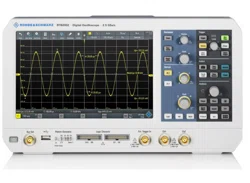Loading ...
Loading ...
Loading ...

Serial Bus Analysis
R&S
®
RTB2000
173User Manual 1333.1611.02 ─ 03
Main characteristics of SPI are:
●
Master-slave communication
●
No device addressing; The slave is accessed by a chip select, or slave select line.
●
No acknowledgement mechanism to confirm receipt of data
●
Duplex capability
Most SPI buses have four lines, two data and two control lines:
●
Clock line to all slaves (SCLK)
●
Slave Select or Chip Select line (SS or CS)
●
Master data output, slave data input (MOSI or SDI)
●
Master data input, slave data output (MISO or SDO)
When the master generates a clock and selects a slave device, data may be transfer-
red in either or both directions simultaneously.
Figure 12-2: Simple configuration of SPI bus
The data bits of a message are grouped by following criteria:
●
A word contains a number of successive bits. The word length is defined in the pro-
tocol configuration.
●
A frame contains a number of successive words, at least one word.
For SPI buses, the R&S RTB2000 provides the following trigger possibilities:
●
On frame start
●
On frame end
●
On a specified bit in the message
●
On a serial pattern at a specified position
12.2.2 SPI/SSPI Configuration
The correct setup of the protocol parameters and the threshold is the condition for
decoding the signal.
To set up and decode an SPI or SSPI signal
1. Press the PROTOCOL key in the Analysis area of the front panel.
2. Select the bus that you want to use: B1 or B2.
3. Select the "Bus Type" = SSPI or SPI.
4. Select "Configuration".
SPI/SSPI Bus (Option R&S RTB-K1)
Loading ...
Loading ...
Loading ...
